The concept of “roadsters” began, bizarrely I think, in 1930s Britain. In a country not known for its copious sunshine (or perhaps because it has so little thereof), car companies began to make small two-seater open-topped cars, modestly powered with a front-mounted engine and rear wheel drive, that could take a young man and his girlfriend on exhilarating trips through the country side, on the tight, twisty and narrow roads so common on this Scepter’d Isle. Thus you had cars like the MG TA:
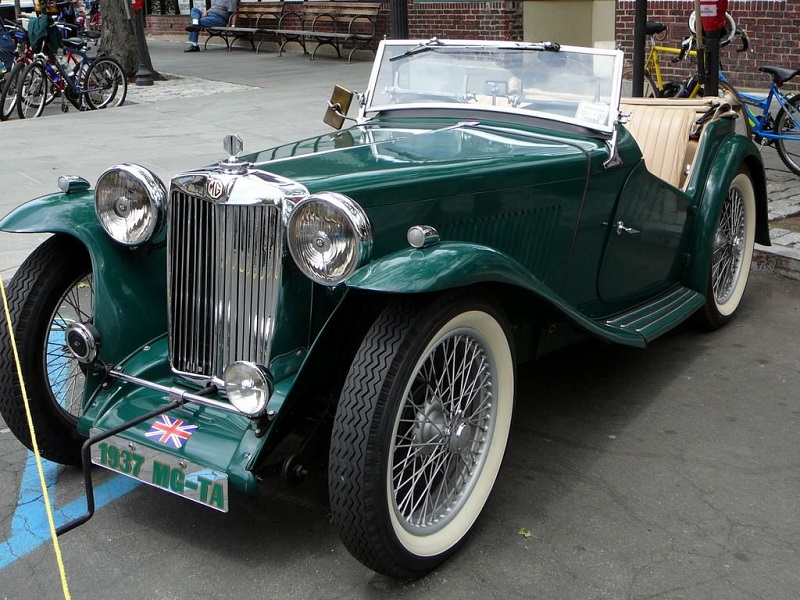
…which after the slight disturbances of the early 1940s, became the MG TF:
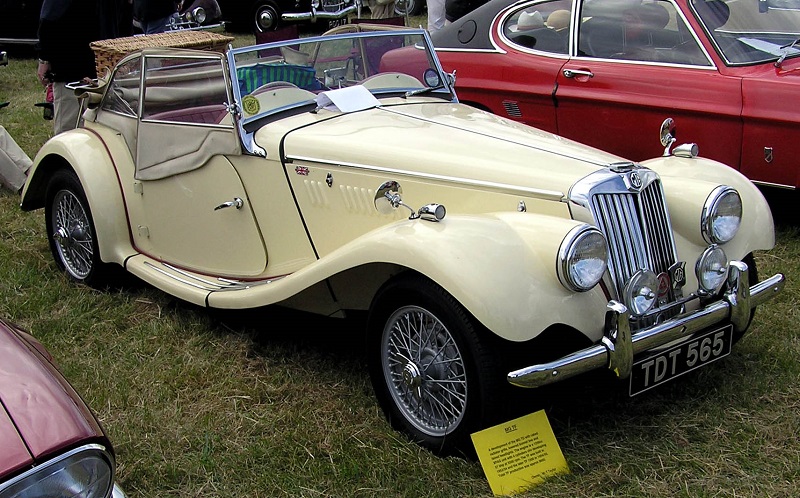
…which turned into the MGA of the late 1950s:
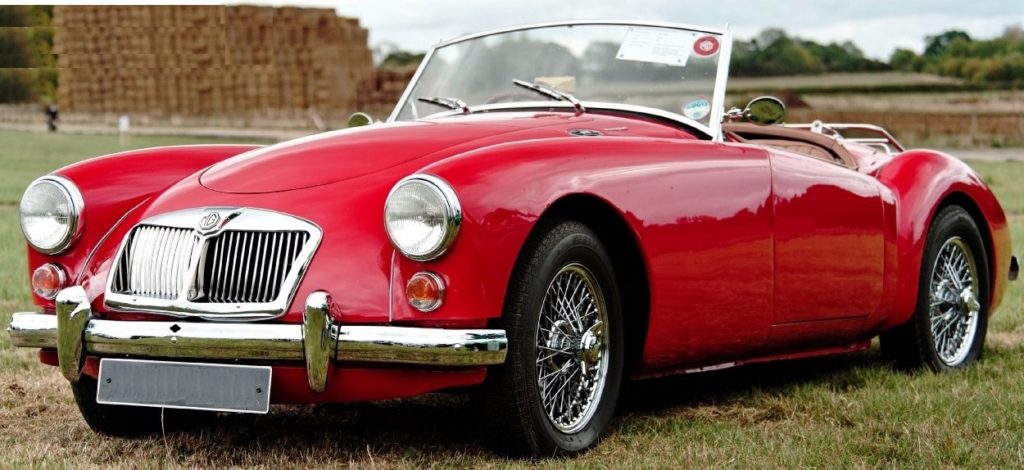
Now you have to understand the concept behind these cars. They were never intended to be racers, nor were they tourers (in the Grand Touring style). They were sports cars — in the literal sense, in that one drove an MG for fun, on short road trips (all road trips in the UK are short: it’s a tiny island, remember) — which meant that the drivers were not going to be stranded hundreds of miles from home by the inevitable mechanical breakdowns and electrical failures, not to mention the fact that these cars leaked like a bucket hit with buckshot; and as we all know, it can rain a bit here in Britishland.
Excuse me while I explore a branch line in my train of thought. Why is it that the Brits can come up with all these excellent concepts, and yet their engineering can suck so badly? Mr. Free Market (who has owned many British cars) once commented that a long trip in his Triumph Stag could move the share price of BP, so much oil did his car consume. For any owner of this type of car, essential items to be carried in the tiny trunk/boot were: a set of wrenches/spanners and other tools, spare hoses, a can of water to refill the radiator every few miles, a can of oil to refill the leaking sump, and a pan to catch the leaking oil while the car was at rest. (It’s easy to see why these were known as “bird and a sponge bag” cars — there was no room for anything else.) My absolute favorite example of this silliness was in an episode of Top Gear, when Jeremy Clarkson had a meeting of a local MG club at some remote town in the country. Every single driver had oil-stained fingers and hands as a result of having had to stop and tinker with their cars on the way down. And speaking of silliness: if you look back at the pic of the 1949 TF above, you will note the huge gap between the windshield and door window — a veritable funnel for driving rain to soak the inhabitants. My only conclusion is that the British nation is a bunch of masochists who have an abiding distrust of things like comfort and reliability when it comes to roadsters. One should not have too much fun when enjoying oneself, after all. [end of branch line]
Of course, the Italians went for the small sports car concept in a big way, incorporating even the unreliability factor (and anyone who’s ever owned an Alfa Romeo Giulietta of that era knows what I’m talking about).
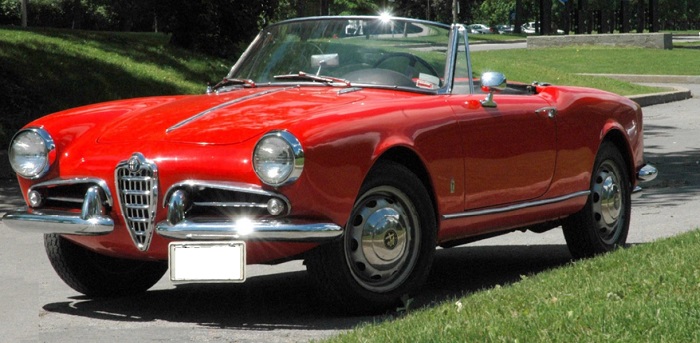
Let’s be honest, here. The concept of a sports car (roadster) is a brilliant one. Of course, it took the Japanese to make the roadster concept truly enjoyable, as Mazda proved when they made a modern copy of the MGA, called it the Miata and sold tens of thousands of them all over the world:
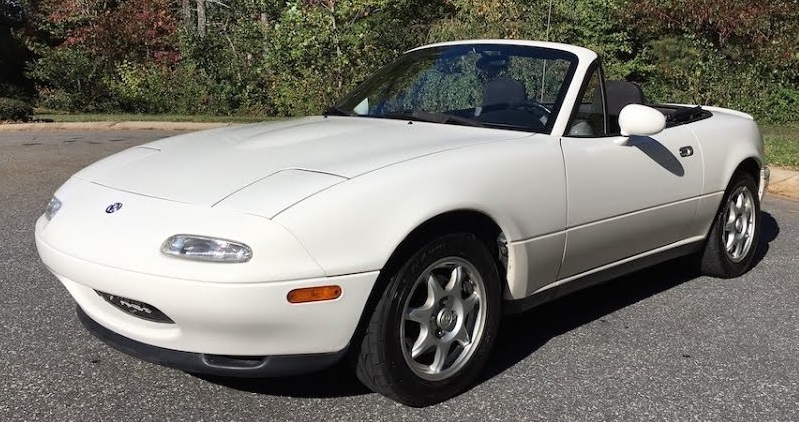
There it is: small underpowered front-mounted engine, stick shift, rear wheel drive, two seats — only with astounding reliability and functionality. From Clarkson again:
The fact is that if you want a sports car, the MX-5 [Miata] is perfect. Nothing on the road will give you better value. Nothing will give you so much fun. The only reason I’m giving it five stars is because I can’t give it fourteen.
That’s the reason that I’m going to buy one of these sports cars, when I finally have a few pennies to spare. Unfortunately, my British heritage (from my mother’s side of the family) means that I’m going to buy not the Miata, but the Fiat 124 Spider derivation:
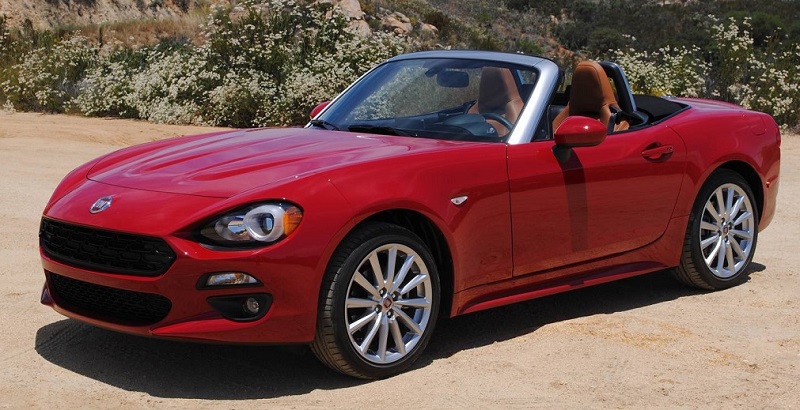
Because one should not have too much fun when enjoying oneself, after all — and I’m pretty sure that Fiat will provide the appropriate levels of failure.

As mentioned, the Fiat is a derivative of the new Miata. It has an Italian drivetrain. I think I’d rather have the reliability of the Mazda.
Yup. I had a Miata for over a decade. Retired it at 243,000 miles. Absolutely marvelous car.
I’ve been driving a 2015 Mazda 6 going on three years now. The car has been faultless, and is a joy to drive. Does great in winter conditions too.
“Why is it that the Brits can come up with all these excellent concepts, and yet their engineering can suck so badly?”
I think I can propose two factors;
1) it isn’t until very, very recently that the automobile has moved from “rich man’s toy” to “essential tool” in the minds of Brits…or most Europeans, for that matter. And, given the Progressive Left’s unwholesome fascination with rail, the self-appointed Cultural Elite have been fighting every step of the way. The Ruling Classes – Greens especially – STILL want the Common Man to give up his motorcar in favor of something a damn sight less useful. An electric runabout that is tied to an outlet for hours at a time. A minicar the size of a bread box. Mass transit of some kind. The Elite, or course, will retain their automobiles, since they will need them for their important comings and goings.
So; toy. Toys break.
2) England and continental Europe failed to embrace the Industrial Revolution to the extent that it was embraced in the United States or Japan. In England Industry was ‘trade’, and ‘trade’ was less reputable than aristocratic idleness or debt. Industrial production expected to be shoddy. My Father was in England in the 1950’s (scholarship); at that time mass made shirts were still made of coarse material and the shirt-tails were joined like a nightshirt. If you wanted the equal of an American Arrow Shirt, you bought from a tailor…and paid tailor prices. Cars were industry; they were expected to be temperamental. It isn’t as if they had been made by CRAFTSMEN.
I can see #2. The English tradition of Master Craftsmenship still involves a lot of hand fitting and customizing. That’s fine for bespoke items, but that system doesn’t transfer well to a lot of cross Trotskyites who see themselves as betraying the revolution by making status symbols for the Bourgeoisie.
I, too love a sports car; however, it was later in my career that I could afford one.
I went German, first with a Mercedes CL230 Coup, then a CL500 Coup that I liked but my wife hated; even I was not enamored with the short tire life and the tendancy to hydroplane on a drop of water here in Houston (LOL). So….., I came back from a hitch in Ghana and my wife insisted we go car shopping – long story short, though my wife wanted me to have an SUV I held out and we bought a BMW 335i which was 4 door to satisfy my wife and had the twin turbos to make it a sports car. After putting 190k miles on the car, I replaced it with the BMW 335i GT which has the same twin turbos, but with all wheel drive – it has the sports car feel with a terrific ability to handle the rain here in Houston – I have 80k miles on it and is extremely reliable and a joy to drive – German engineering all the way for me.
My current mount is a BMW 328 convertible. It’s not the turn-on-a-dime-and-give-change machine the Miata is, but it’s a whole lot more comfortable for a long drive.
The 328i and 335i have the same engine; however, the twin turbos of the 335i series is something you need to try; both for quick and “get out of dodge” AND as you say, very comfortable on a long drive. I do miss having a convertible, but I make do with an extended sun roof.
I have the honour to be financial patron to a 1965 Sunbeam Alpine proudly manufactured in the UK by the Rootes Group, also makers of those stellar automotive wonders, Hillman, Humber, Singer, Talbot, Commer and Karrier.
From time to time Mr. Stromberg and Mr. Lucas get together, work in harmony and allow me a short drive in the Sunbeam, knowing full well that it will soon start to rain and the soft top will, once again, fail to open properly.
Then back to the garage for more greasy fingered cursing.
But Mr. Stromberg and Mr. Lucas have surprises coming. The internet has put me in touch with some American engineering gentlemen who are sending me replacements for the wretched Stromberg carbs and Lucas electrics. For a long time I tried to keep the thing “original” but to hell with that.
A minor correction Kim:
The MG-TF was an early 50’s car (52-55?), and was the third Post-war MG we saw here in The Colonies preceded by the TC, and the TD. It’s last iteration, the TF-1500, sported the engine that would be in the MG-A.
As to the Miata, many of those who love and admire Brit sportscars always considered the MX-5 to be a practical recreation of the Lotus Elan of the Mid/Late-60’s.
A Warning of Doom (found on the badge affixed to the side-cover of a Triumph motorcycle motor): Made to British Specifications!
Spend a few extra bucks and get the Abarth version of the Spider. It’s worth every penny, and a very fun little thing to play with.
My old Lotus Elan, power windows included, weighed right at a 1,000 pounds less than the 2,500-pound Miata. And mine had more ponies under the hood.
A 3-liter Austin-Healey was much more reliable with a Bendix Elmira fuel pump and a 350-hp Corvette motor coupled to a Borg-Warner T-10 transmission. A wee tad better for performance as well. 🙂
The way to avoid oil leaks from the motor of a 1950s/1960s Alfa? Weld it.
I learned to drive in my Dad’s ’49 TC. Also helped him rebuild it, including all the wood elements under the sheetmetal. Fun times. Thing was eventually a deathtrap, though – the right front wheel fell off (OFF) coming into our driveway after a highway run one day. This was eventually traced to a machining mark / stress riser left on the front spindle during manufacturing. Eventually sold it to a real collector.
But then I went and bought a MGB. All the usual fun and issues, except…the thing never, as in NEVER, leaked oil. I still miss that car.
Has anyone driven the MGC-GT? The neighbor of a pilot colleague of Dad’s (in Surrey) owned one, but I never had a chance.
“Why is it that the Brits can come up with all these excellent concepts, and yet their engineering can suck so badly?”
Perhaps having their best engineering talent building infrastructure in the Empire, with the remainder going to projects that produced such masterpieces as the SMLE, Spitfire (Supermarine type) Hurricanes, Mosquitoes and Typhoons?
I always thought of the SMLE as a product of the same British engineering mindset as their cars – sort of good looking, simple, a bit quirky, and definitely obsolete. Yes it worked but there were lots better options available at the time. Unfortunately the Brits were running out of everything – money, manpower, and ideas – by the end of the war. They never really had the infrastructure to get mass production sorted out. That’s why the British army was equipped with Sherman tanks, White Halftracks and jeeps – and they probably would have carried Garands if they hadn’t had millions of rounds of the old rimmed .303 ammo in stock.
My first car at age 17 was a 58 “Bug Eye” Austin Healy Sprite and I survived driving that thing as a teenager, barely. It was a go cart with a body that could just manage to beat a VW Bug in a 1/4 mile drag race. A true sports car with side curtains for windows, twin carbs on a little 4-cylinder Morris Minor engine and actually decent drifting around turns.
Then about 30 years ago I bought a TR3A which was a strong running roadster and I was part of the Oklahoma City Triumph Owners club. When we had get togethers we would slip a pice of butcher paper under the engine when each Triumph showed up, click a stop watch for 60 seconds and give awards for the smallest and largest oil stain on the paper. I loved the sound of the TR3 shifting through the gears both up and down with that throaty Ferguson Tractor engine that had two carbs stuck on.
Wish I had all my old Brit cars now but I would have hated to have paid for the upkeep and storage to keep them in top shape. Besides that I always need the money for other things when I sold them.
Have you looked at the Morgan cars?
As for the source of that famous British quality control, I’ll just utter one word: unions.
The British are great ideas people, and British master craftsmen are second to none. But, when your stuff is made by angry, bitter Marxist who spend more time striking than working, you will get stuff that is ambitious, but rubbish.
Agreed.
Decades ago when Labour was running the UK Govt, there was a newspaper article on some Labour Minister who had congratulated himself on reorganising British Leyland. In a wish to provide clear descriptors, his dept had re-named the Jaguar Works as “Coventry Heavy Car Plant number 2” (or similar).
Nothing about the pride of being Jaguar; nought about quality; b.all about humans. Just bitter, twisted, Leninist-Marxist clap-trap.
Detail engineering demands an obsession with the small details. For some reason I’ve never quite understood, the British can’t do it. They do brilliant top-level conceptual work, but the details escape them. The Japanese are the opposite – brilliant detailed design, but lacking the creative spark for overall design.
Which is why the Miata is what it is. Mazda bought three Lotus Elans, shipped them to Hiroshima, and figured out what made a British sports car what it was. Then filled in the detail design work the Brits couldn’t be bothered with.
Kim the current Miata model may have a small engine but I wouldn’t be surprised if if it could tow an MG TF through the quarter mile faster than the TF could do it by itself.
Actually, the Miata was designed at Mazda’s SoCal “Skunkworks” by Americans – one of which IIRC was the son of the then current Chief of Design at GM. They were all hard-core “gear heads”.
My first car was an MG B.
It was lots of fun, and I learned an awful lot about fixing cars.
Some days, when the weather’s nice and I’m looking at a twisty road, I even miss it.
.
But I can’t say I miss the occasional spectacle of the hood flipping open at highway speeds.
Or the headlights reliably going out when crossing a railroad track.
Or having to replace the cap and rotor after a trip.
Or keeping the carberators tuned.
Or needing to break out the ether to get the thing running if it was the slightest bit cool.
Or… Well, you get the drift.
It was a dream to drive.
But often the one where the harder you run, the slower you go.
Their bikes weren’t any better. At the tender age of 16 I bought a low mileage BSA Gold Star. I learned that the reason it was low mileage was because the former owner couldn’t keep it running. I asked the seller about oiling the chain. He replied “Don’t worry about it. Lots of oil drips off the engine and enough hits the chain to take care of it.” My bike did “mark the spot”. Later on I bought a 67 Triumph Spitfire. It was a fun car when it wasn’t raining and I liked the way that the whole front end sheet metal lifted up for servicing. Then I considered why I had to lift up the front end up so often. The Spit’s swing axle rear got away from me on a couple of occasions when I pushed it a little too hard. My last experience with British Cars involved a 67 Sunbeam Tiger that I bought when I got out of the navy in 1974. It really wasn’t a classic yet – just a clapped out hot rod with the best and worst of both sides of the Atlantic. Plenty of horsepower from a very reliable Ford small block V-8 and a decent Ford clutch and trans. Unfortunately it had the awful Lucas electrical parts, a British hydraulic system that required rebuilding every six months or so – and yes I did use Castrol brake fluid but it didn’t matter, and a soft top that made you feel like you were sitting under a waterfall when it rained. Thankfully the car came with a factory hard top which only leaked a little bit and most of the time I ran with the hard top on. I got married two years later and the wife decided that we needed a “civilized” car. These days I’m driving a Subaru Outback which is about as far from a Brit roadster that you can get and my utility vehicle is an older Dodge pickup. I wish that I’d never sold that Tiger. Everybody needs a Maxwell Smart car once in their life.
Now for the obligatory joke which I don’t think anybody’s posted yet. Why do the British drink warm beer? Because they have Lucas refrigerators.
But they could approach “doing it right”, too.
Triumph TR-6. Think of it as a pre-Miata on steroids.
Sadly though, that was the apex of the Triumph lineage. They lost the track with the gawdawful TR-7, and only made it worse with the TR-8.
I remember seeing them in the damn showroom, with the foam-injected dashboards already peeling and curling in the Texas sun.
That old saying: “Rust Never Sleeps?” True, and it drove a TR-7/8, withal.
Jim
Sunk New Dawn
Galveston, TX
Well, I’m a motorcycle guy more than a car guy but the way I see it there is at least a glimmer of hope for those who love British cars.
As LTDavel said, British motorcycles were known for being fast, maneuverable, and hideously unreliable, just as their cars were (non-standard Whitworth fasteners, Lucas electricals, leaky split engine cases, etc, etc – the same misery that Brit car owners lamented.)
When the original Triumph motorcycle company finally went belly-up in the mid 1980’s (after decades of decline) the name was purchased by an English businessman named John Bloor. Bloor rebuilt the company from the ground up, with emphasis on performance and reliability. Triumph was reintroduced to the market in 1990 and into the USA in 1995. Since then, Triumph has become one of the most reputable and respected motorcycle brands in the world. The days of leaky motors and unreliable electricals were gone. They did establish a factory in Thailand to assemble some motorcycles, but the rest are still made at the factory in Hinckley, UK.
Modern Triumph motorcycles are every bit as reliable as anything made in Japan, Germany or the USA (Italian bikes are gorgeous but I wouldn’t own one.)
I’m currently on my 3rd “Modern” Triumph. My Bonneville looks just as gorgeous as its namesake from the 1960’s. I’ve simply lost track of the number of times I’ve been asked at a gas station “What year is that?” and seen the shock when I tell the person asking that it’s a 2002 (the air-cooled twin Bonneville was reintroduced into the Triumph lineup in 2001.) A sharp eye could spot the overhead cam engine and the lack of a kick starter is obvious but other than that, it’s nearly identical to the classic Brit bike.
So my point with all of this is that if the Triumph motorcycle company could resurrect itself from the grave, there’s no reason why any Brit car company could not do the same.
Whether there is a DEMAND for such when one can simply buy a Miata is a different issue.
Agreed. My ’12 Bonnie is a dream, and has never leaked a drop of anything, starts when I push the button, and has never given me second thoughts about buying it.
Though it’s a Commemorative Model (110th Anno), the frame was made in Thailand (has that irritating “T” in the 11th position) but I am assured(?) that it was assembled in Blighty.
(riding since ’57)
Did anyone other than I notice that the three MGs all had provisions for hand cranking?
So did a lot of the early Ferrari’s…..it was a 40’s thing.
Do you have any idea how much money Mr. Snap-On gets for Whitworth wrenches and sockets? For a while I did occasional shade-tree mechanic work on older Limey cars. My joke was that not even a Crescent wrench will fit Whitworth nuts and bolts. 🙂
In 1957 in Paris, I had a 1953 Triumph Thunderbird. “Tighten all the nuts and bolts!” was a weekly chore. And always check the oil in the clutch case so the little cork inserts don’t burn. Learning about the Uni-Syn to tune the two SU carbs helped quite a bit in later years.
I still have my Uni-Syn in the “test gear” drawer of my roll around tool box. The last time I used it was about 20 years ago to help a friend with his 4 carb 140 HP Chevy Corvair. Friend still has the Corvair and drives it occasionally.